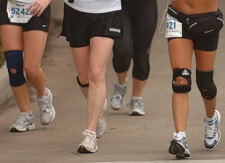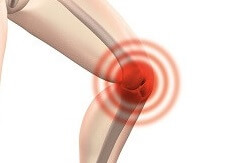- Home
- Knee Pain Diagnosis
- Swollen Knee
- Swelling Below the Knee
Swelling Below The Knee
Written By: Chloe Wilson, BSc(Hons) Physiotherapy
Reviewed by: KPE Medical Review Board
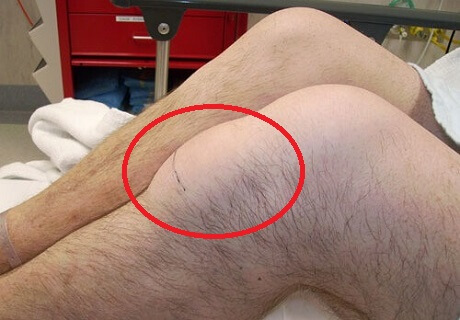
Swelling below the knee is a common problem that can affect people at any age.
There are lots of possible causes of swelling or a lump under the knee but in most cases it is nothing too serious.
There may be a defined pocket of swelling, a hard lump under the knee, generalised swelling around the joint or the swelling may extend down into the shin and calf.
Swelling under the knee may be caused by an injury, overuse, muscle imbalance, underlying medical conditions or an infection. The swelling may come on gradually or suddenly, be constant or fluctuate and may be getting better or worse.
Here well will look at the different causes of swelling below the knee and the common features and treatments for each. If you’re swelling is more around the knee joint than below it, check out the Front Knee Swelling article, or if pain is more of a problem than swelling, check out the Pain Below The Knee article.
What Causes Swelling Below The Knee?
The most common causes of swelling below the knee are:
- Knee Bursitis: inflammation of one of the knee sacs
- Osgood Schlatters: hard lump below the knee, common in teenagers from overuse
- Bakers Cyst: inflammation at the back of the knee
- Patellar Tendonitis: Thickening of the tendon below the kneecap
- Knee Arthritis: degeneration and wear and tear of the knee bones and cartilage
- Knee Gout: inflammation from build-up of uric acid
Each of these causes of swelling below the knee will present differently and will require specific treatment. So we’ll start by looking and the five most common causes of pain and swelling below the knee, then we’ll cover some of the less common causes of swelling under the knee, and we’ll finish with looking at the best treatment options for each.
1. Knee Bursitis
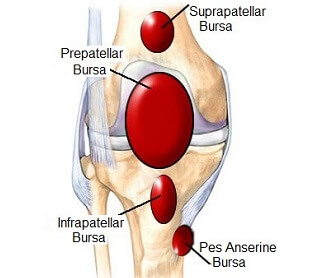
The most common cause of soft swelling below the knee is knee bursitis.
The knee bursa are small fluid-filled sacs that are located at various points around the knee. They sit between the bones and soft tissues to enable smooth, friction-free movement as the knee moves.
If there is too much repetitive or excess friction or force through the bursa e.g. from kneeling for long periods, muscle tightness or a knee injury, then the bursa gets irritated. This irritation leads to inflammation which can result in a localised pocket of knee swelling. Knee lumps from bursitis tend to be well-defined and can range in size from a small grape to a large squashy grapefruit.
There are a number of different bursa that can become inflamed resulting in front knee pain and swelling below the knee:
- Infrapatellar Bursitis: causes a soft lump below knee cap
- Pes Anserine Bursitis: causes a small pocket of swelling below knee on inner side
- Prepatellar Bursitis: causes swelling at front of knee
You can also get swelling at the back of the knee from bursitis but we’ll look at that separately. You can find out more about the causes, symptoms, diagnosis and treatment of bursitis swelling below the knee in the Knee Bursitis section.
2. Osgood Schlatters
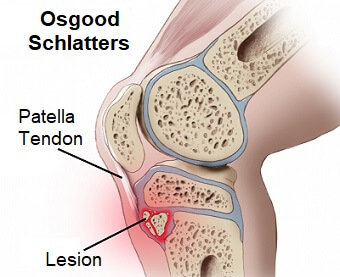
The most common cause of a hard lump below the knee is Osgood Schlatters Disease.
Osgood Schlatters is the most common cause of pain and swelling below the knee in teenagers, but can affect people at any age.
Excessive tension through the patellar tendon causes inflammation and irritation where the tendon attaches to the shin bone, resulting in a hard lump about 2cm below the knee. This tension is usually caused by muscle tightness, particularly after a growth spurt, or repetitive overuse, often from sports involving lots of running, kicking and jumping.
Increased tension through the patellar tendon pulls on the bone where the tendon attaches causing it to lay down excess bone in an attempt to protect itself. The longer Osgood Schlatters goes untreated, the larger the hard lump below the knee will likely become.
Swelling below the knee from Osgood Schlatters typically only affects one knee but in around a quarter of cases, affects both knees simultaneously. Pain below the knee from Osgood Schlatters typically comes and goes, getting worse with activity and improving with rest.
Treatment for Osgood Schlatters usually involves a combination of knee stretches and strengthening exercises, knee straps, rest from aggravating activities, ice and medication and it can take anything from a few weeks to a few months for the hard lump below the knee to disappear.
You can find out loads more about how Osgood Schlatters causes swelling below the knee including the causes, symptoms, diagnosis and treatment options in the Osgood Schlatters Disease section.
3. Bakers Cyst
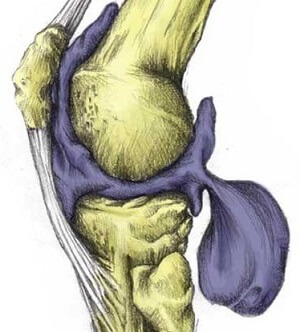
The most common cause of swelling below the knee at the back of the knee is a Baker’s Cyst.
A bakers cyst is caused by inflammation and excess fluid build-up in the popliteal bursa found at the back of the knee.
Anything which causes excess fluid to form in the knee joint, such as a knee injury or arthritis can result in a baker’s cyst as the fluid leaks out of the back of the knee joint and collects in the popliteal bursa. Osteoarthritis and meniscus tears tend to be the most common culprits of a Baker’s Cyst.
As the fluid collects in the bursa, it causes swelling at the back of the knee, which often resembles a squashy orange and the swelling may extend below the knee. In some cases, the cyst may rupture causing the swelling to seep out below the knee and down the back of the calf.
Swelling below the knee from a baker’s cyst can vary in size averaging around 10cm2. Along with the obvious swelling, there may be pain behind the knee extending down into the calf, and the knee often feels tight and stiff. As the lump gets bigger, it can make kneeling quite uncomfortable.
Swelling below the knee from a Bakers Cyst is usually treated with a combination of ice, medication, aspiration (where the fluid is drained with a needle), injections and exercises. Occasionally surgery may be required if the swelling below the knee is causing considerable problems.
You can find out loads more about swelling behind the back of the knee from a bakers cyst including the causes, symptoms, diagnosis and treatment options in the Baker's Cyst section.
4. Patellar Tendonitis
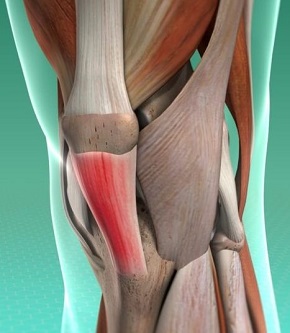
Thickening of the patellar tendon, known as patellar tendonitis, can also cause swelling below the knee.
The patellar tendon is a thick, cord-like structure that connects the quadriceps muscles to the shin bone.
When there is repetitive tension or friction through the tendon, small tears develop leading to degeneration and inflammation.
The tendon gradually thickens forming a small lump under the knee cap in the tendon which is often tender to touch.
Swelling below the knee from patellar tendonitis usually affects people who play sports involving lots of jumping or kicking. Over-training and muscle weakness and/or tightness also increase the likelihood of developing the condition.
Alongside swelling below the knee, common symptoms of patellar tendonitis include pain just below the kneecap that gets worse with activity, and knee stiffness. Symptoms typically build up gradually over time until the pain becomes almost constant.
Treatment for patellar tendonitis typically involves a combination of rest, ice and medication to reduce the swelling below the knee, exercises to improve the strength, stability and flexibility at the knee and in rare cases, surgery. It is important to rest as much as possible, avoiding any aggravating activities initially, and many people find it helpful to wear a knee strap when they return to sports.
You can find out more about how patellar tendonitis causes thickening and a lump under the knee cap, common symptoms, diagnosis and treatment options in the Patellar Tendonitis Section.
5. Gout Knee
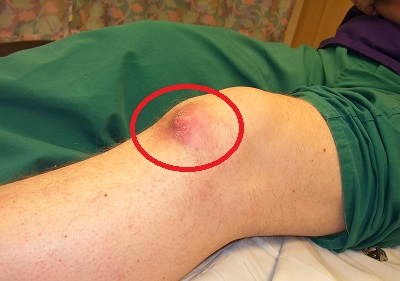
If your swelling below the knee came on very suddenly and is associated with redness and warmth in the knee, then it may be from gout knee.
Gout pain and swelling below the knee is caused by a build-up of uric acid in the knee joint.
Uric acid is a waste product of various foods and drinks that our bodies usually get rid of in urine, but with gout knee there is a problem with how the body breaks it down.
This causes crystals to form in the knee joint, triggering an inflammatory response resulting in swelling in and around the knee. Gout swelling below the knee usually comes on very rapidly, often at night, can be extremely painful and may be associated with a fever. In some cases the whole knee joint swells, in other cases, small, firm lumps form under the skin, known as tophi.
Gout tophi lumps under the knee may be hard or soft and can range from being just a few millimetres to fist-sized.
You can find out all about the causes, symptoms, diagnosis, treatment for gout swelling below the knee in the Gout Knee section, including some useful advice on how to prevent recurrent attacks.
Other Causes Of Swelling Below Knee
So far, we have looked at the five most common causes of swelling below the knee. There are a number of other possible causes of swelling under the knee but they tend to be less common and may extend right down the leg.
1. Arthritis
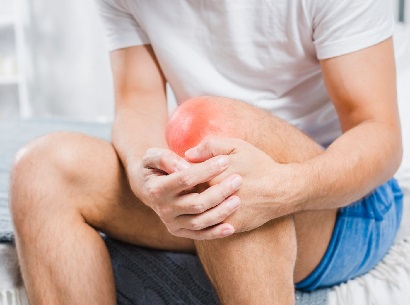
Swelling below the knee in people over the age of 60 is often caused by arthritis.
There may be wear and tear of the knee bones and cartilage known as knee osteoarthritis, or chronic inflammation in multiple joints from rheumatoid arthritis.
Knee osteoarthritis can cause swelling below the knee due to the increased pressure on the knee joint caused by the degeneration of joint tissues and the formation of knee bone spurs. This can lead to inflammation and fluid build-up in the knee joint, which can cause swelling and pain below the knee.
Rheumatoid arthritis, a type of autoimmune disease, can also cause swelling below the knee. Rheumatoid arthritis causes inflammation of the joints, which can lead to swelling, stiffness and pain.
Knee arthritis treatment usually involves a combination of medications, physical therapy, lifestyle changes, and in some cases, surgery.
Medications such as non-steroidal anti-inflammatory drugs (NSAIDs), corticosteroids, and disease-modifying anti-rheumatic drugs (DMARDS) can help reduce knee swelling and pain. Physical therapy can help maintain or improve range of motion, strength, and balance. Lifestyle changes such as maintaining a healthy weight through diet and exercise, avoiding smoking, and regulating stress levels can also be beneficial. In some cases, joint replacement surgery may be recommended to relieve pain and restore function in the knee.
You can find out all about the causes, symptoms, diagnosis and treatment options, including the best diets and supplements for arthritis in the Knee Arthritis section.
2. Peripheral Edema
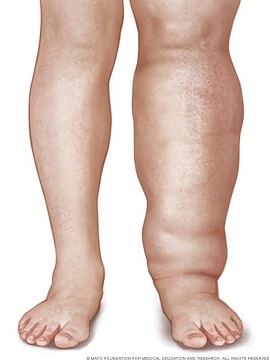
Swelling below the knee that extends down the legs and into the feet is often caused by peripheral edema.
Peripheral edema is caused by a build-up of fluid in the body’s tissues, often affecting the legs. It can be caused by a number of factors including poor circulation, inflammation, organ failure, reactions to certain medications, and heart or kidney disease.
Symptoms of peripheral edema typically include swelling, tightness or pain in the legs, and skin discoloration. In some cases, the swelling below the knee may be accompanied by a feeling of heaviness or tightness, or a tingling sensation.
You may also experience other symptoms such as increased heart rate, breathing difficulty, and fatigue.
Treatment for peripheral edema swelling under the knee usually involves a combination of lifestyle changes, medications, and physical therapy. Lifestyle changes may include avoiding sitting or standing for long periods of time, limiting salt intake, maintaining a healthy weight and wearing compression stockings. Medications such as diuretics and blood pressure medications can be used to reduce the swelling below the knee and physical therapy can help improve circulation and strengthen muscles that support the legs.
3. Deep Vein Thrombosis (DVT)
One of the more serious causes of swelling below the knee is when a blood clot forms in the deep veins of the legs, usually in the calf, known as a deep vein thrombosis or DVT. This can lead to swelling under the knee as well as pain, redness, and warmth around the knee.
A DVT may be caused by a number of factors, including inactivity e.g. long plane or car rides, smoking, surgery, pregnancy, cancer, and certain medications. Other risk factors include age and having a family history of DVT, being overweight or obese, and having an existing medical condition such as heart disease or diabetes.
Swelling below the knee from a DVT is often treated with anti-coagulant medication, aka blood thinners, which help break-up and prevent blood clots. Leg elevation and compression stockings can help reduce swelling below the knee and improve circulation. In some cases, surgery may also be necessary to clear the clot.
A DVT can be a medical emergency and should be treated promptly. If the clot breaks off and travels to the lungs, it can cause a life-threatening condition called pulmonary embolism. It is therefore important to contact your doctor if you have any symptoms of DVT, such as pain, swelling, redness, or warmth around the knee.
4. Cellulitis
Cellulitis is a bacterial infection that can cause swelling and pain below the knee. It can be caused by bacteria entering the skin through a cut, scrape, insect bite, or other break in the skin, or by infection entering the body through a surgical wound. Risk factors associated with cellulitis include diabetes, obesity, skin conditions, a weakened immune system, and certain medications.
Symptoms of cellulitis may include redness, warmth, tenderness and swelling below the knee which may extend right down into the feet. Other symptoms may include fever, chills, fatigue, joint pain, and headaches. Cellulitis can spread quickly to lymph nodes and other nearby tissues, potentially leading to serious complications such as sepsis, a life-threatening bloodstream infection, so prompt treatment is vital.
Swelling below the knee from cellulitis is typically treated with antibiotics, either orally or intravenously and hospitalization may also be necessary to help control the infection. It is really important to keep the affected area clean and dry and to keep any open wounds properly covered to help reduce the risk of infection.
In most cases, with proper treatment, cellulitis infections should improve within a few days to a week, although some people may have lingering symptoms of swelling under the knee or redness for several weeks. It is important to follow your doctor’s instructions and take all prescribed medications for the full course of treatment to ensure a successful recovery.
Rare Causes Of Swelling Under Knee
Other possible causes of swelling below the knee include:
- Varicose Veins: swollen, twisted veins that cause swelling, pain and a feeling of heaviness
- Injury/Trauma: e.g. broken tibia or fibula
- Medical Conditions: e.g. kidney disease
- Lymphedema: causes swelling due to blocked or damaged lymphatic system
- Infections: bacterial or fungal infections or infectious diseases e.g. Lyme Disease
- Sarcoma: malignant growth, most common in young adults
Any new incidence of swelling below the knee should be assessed by your doctor to ensure you get the right treatment. If there is significant calf or knee swelling, intense pain, unexplained weight loss or any warmth or redness around the knee, see your doctor immediately.
Swelling Under Knee Treatment
The best treatment for swelling below the knee will depend partly on what the underlying cause of the swelling is. This initial aim is usually to reduce the pain and swelling below the knee and once that is under control you can begin other treatments such as rehab exercises. T
reatment for swelling under the knee may involve a combination of:
- Rest: Avoiding aggravating activities
- Ice: regularly applying ice can help to reduce pain and inflammation
- Compression: tubigrip compression bandages help to reduce swelling and support the knee
- Elevation: resting with your leg elevated above your heart helps fluid to drain
- Aspiration: fluid can be removed from a lump under the knee with a needle
- Injections: corticosteroid injections can help reduce pain and inflammation
- Physical Therapy: can help at all stages and may include a combination of electrotherapy, massage, taping, bracing and exercise advice
- Exercises: strengthening and stretching exercises can be helpful once the swelling starts to subside
You can find out lots of more about how to treat swelling below the knee in the swollen knee treatment section.
Alternatively, if you are looking for treatment advice on the conditions we have looked at here, check out:
- Knee Bursitis Treatment
- Osgood Schlatters Treatment
- Bakers Cyst Treatment
- Patellar Tendonitis Treatment
- Gout Knee Treatment & Prevention
- Knee Arthritis Treatment
Swelling Below Knee Summary
There are lots of possible causes of swelling below the knee.
A hard lump under the knee is usually from Osgood Schlatters disease (front of shin), patellar tendonitis (just below kneecap) or knee bone spurs
A soft lump under the knee is often caused by infrapatellar bursitis (below the kneecap), prepatellar bursitis (around the knee cap), pes anserine bursitis (on the inner side below the knee) or a baker’s cyst (behind the knee)
Generalised swelling around the knee that fluctuates may be from arthritis, particularly in the over 60s
Swelling below the knee that extends down the leg towards the foot may be from peripheral edema, infection, cellulitis or lymphedema
Swelling under the knee associated with redness and warmth may be due to gout knee, a DVT or cellulitis
In most cases, swelling below the knee will improve with a combination of rest, medications, physical therapy and exercises, but occasionally it may be a sign of something serious such as a malignant tumor or DVT. Any new incidence of below knee swelling should be assessed by your doctor as soon as possible. If pain is more of a problem than swelling, check out the Pain Below The Knee section.
You may also be interested in the following articles:
- Swelling Behind The Knee
- Front Knee Swelling
- Swelling Above The Knee
- Side Knee Swelling
- Front Knee Pain
- Knee Pain On Stairs
- Knee Pain At Night
Page Last Updated: 20/05/23
Next Review Due: 20/05/25
